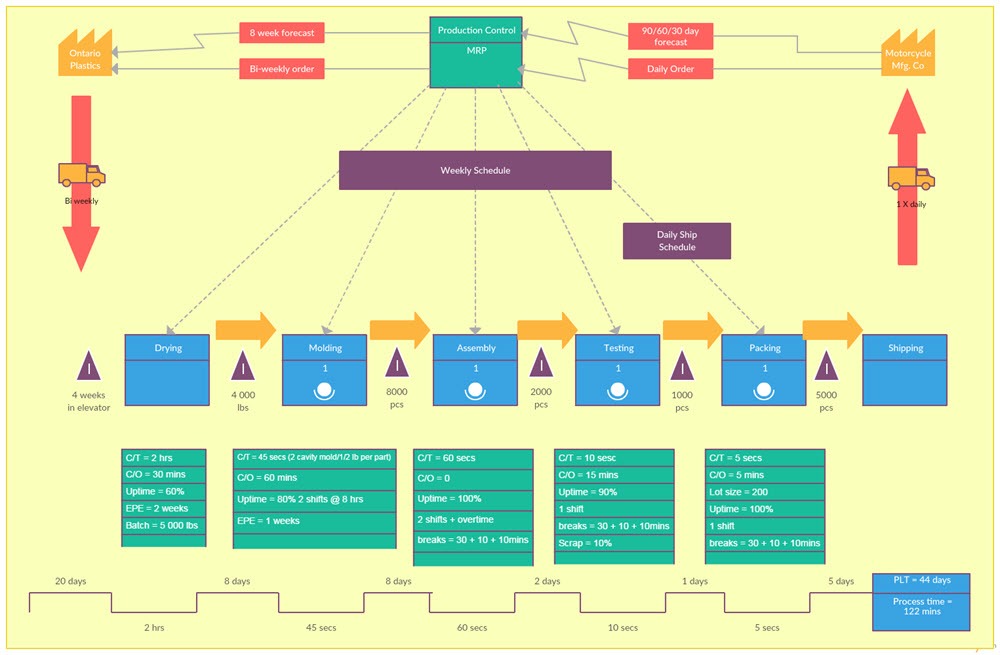The value stream map is a chart which illustrates and also analyses the various steps that are involved in the delivering of a particular service or manufacturing of a product. Whenever an individual maps the present state of a process from the start to the end, areas which are not important to the process should be found and those areas should be reduced.
Value stream mapping began with lean methodology as it is a prevailing way to envisage the main goals of lean methodology which are to manage every waste including defective parts, overproduction and the movement of products and people.
Value Stream Mapping Steps
Below are the steps to take when developing a value stream map.
Understand Value
This very first value stream mapping step is to comprehend the perception of “Value-Adding Activities.” The three conditions for value adding activities are;
- The customer needs you to do it.
- The information is being transformed into the end product.
- It is done well the very first time.
Any action that exists beyond these three criteria is regarded as waste.
Once the value for the company as well as the focus is understood and defined, the value stream mapping can then be developed.
Define the Focus
A value stream map doesn’t keep track of every of the possible path which the process could take. It only tracks one part or a family of parts, transactions or services via the process. So to define the focus, we can make use of tools to assist in the understanding of the particular/family of products that is most profitable.
When picking the product/family of products to map, the following below are needed to be considered;
- Defect rates
- Largest dollar volume
- Customer return rates
- Complex products (use of the most processes)
- Higher proportion of units
These first two value stream mapping steps are very important when developing the value stream mapping.
Go to the Gemba
Don’t ever attempt to develop a value stream map by making use of SME (subject matter experts) only without trying to experience the process yourself. This value stream mapping step involves you watching the whole process unfold in your presence and then, taking notes. The value stream mapping has to be developed in a place where the team can easily and quickly get access to the process. This is also referred to as go to the Gemba.
Work Backwards
The most challenging aspect of drawing a value stream map is to not make it into a flowchart in which all the various paths of the process can be tracked. The trick to preventing this mistake is to begin at the end of the process and work your way backwards. When you begin from the final user and work your way backwards, you have no option but to track only one particular thing.
Define the Main Value Stream
From the data that has been gathered from ‘going to the Gemba’ and ‘SMEs’, we can now define the main value stream mapping steps.
Fill in the Waiting Time
After we have defined the main value stream mapping steps, then we can fill in the queue time between every process. In most value stream maps, the attention is on the process cycle time.
Fill in the Important Process Data
Input all the important process data. Some examples of the process data are; change over time, problems for each day/defects, process cycle time, rate/pace/ TAKT time, shifts, batch size, first pass yield and other data that has been deemed important to the process.
Include the percentage of the value added (%VA)
Sum up every of the data in the value added section and divide by the whole process cycle time (that is the time taken for a product/family of products to move through the whole value system). Then, convert the outcome to its percentage by multiplying it by 100. The outcome of this calculation is the percentage of value added (%VA).
Interpret the Value Stream Map
After all the value stream mapping steps have been taken, the value stream map should by now be a pictorial display of the process and everything that has occurred to the product.
The value stream map should assist in the building of a roadmap for the continual improvement of projects in order to get the process to their desired state.






